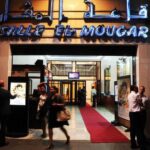The National Museum of Fine Arts of Algiers, is one of the largest art museums in Africa. Open to the public since May 5, 1930, it is located in the Hamma district, on the side of the Hamma test garden.
The museum with its 8,000 works, its collection includes painted works, drawings, engravings and old prints, sculptures, antique furniture and decorative art, ceramics, glassware, as well as a collection of numismatics. Among the works on display are paintings by Dutch and French masters such as Brugghen, Van Uyttenbroeck, Van Goyen, Monet, Matisse, Delacroix, Renoir, Gauguin and Pissarro. But also iconic Algerian artists, such as Baya, Yellès and Racim. The museum houses sculptures by Rodin, Bourdelle and Belmondo
History of the museum
The beginnings
The Museum of Fine Arts in Algiers was born of the will of politicians at the end of the nineteenth century, at the time of French Algeria. Originally it was in the dilapidated premises of the Society of Fine Arts founded by Hippolyte Lazerges in 1875 that the municipality of Algiers preserved its works of art. It was not until 1897 that it acquired a real museum, devoted to antique and Muslim collections, even if it is housed in the buildings of a normal school. In 1908, a former barracks of the army located at the current location of the Safir Hotel is devoted to art. It was inaugurated on May 30, 1908, and this creation was long in demand because the Salle des Beaux-Arts which served as a museum was very badly disposed and could not contain the works acquired by the municipality1. This new municipal museum was run until 1910 by Charles de Galland, but it is old and not functional. The quality of the museum was not sufficient, so that the travelers and the Algériois disdain and ignore the so-called « municipal » museum which is in an unfavorable, dilapidated, inaccessible, even poorly surrounded and poorly lit room2. Thus, the municipal museum of Algiers closes its doors after twenty years of operation between 1908 and 1928. A national museum of Fine Arts takes back its fund by enriching it of new acquisitions.
The birth of the Museum of Fine Arts
With the opening of the « villa Abd-el-Tif », a real need in this area is felt and the project is entrusted to a little known architect, Paul Guion. The site is chosen, Hamma, opposite the Garden of Test and not far from the Villa Abd-el-Tif, on the hill with boars. Paul Guion opts for a symmetrical and rectilinear monumentalism whose architectonic elements drawn from Mediterranean art will find echo in the admirable furniture designed and designed by Louis Fernez, professor at the National School of Fine Arts of Algiers and some of which pieces are ordered from Francis Jourdain. Begun in 1928, the work was quickly completed, thanks to credits freely granted. As for the architecture of the museum, it was well admired by its ideal location and its style associating « past and current data ». This clean architectural style symbolizes the construction of the image of a young and modern country, but also concerned with its traditions. The immense size of the new museum is worthy of our consideration: thirty-five rooms of paintings, a gallery of sculptures, a gallery of casts, a library and a cabinet of prints. The building is divided into three floors: on the ground floor is the casting room, the first the modern sculpture room and the upper floor, the paint galleries. The Musée des Beaux-Arts in Algiers, inaugurated on May 5, 1930, will be open to the public only in April 1931. It was the centenary of Algeria which promoted this project of the National Museum of Fine Arts of Algiers . Celebrating its colonies, celebrating its victories of the Great War, the France of the Third Republic can not ignore the first centenary of its presence in Algeria. Prepared since 1923 under the aegis of the governor, General Steeg, a magnificent prelude to the Vincennes Exhibition is developed by a law of 1928 which creates a Superior Council and a General Commissariat of the Centenary. It was to show what France had achieved in Algeria since its installation, the results obtained, the progress made. A budget originally set at 134 million is reduced to 82 million and in the metropolis, all good will strive to spread the good word of French Algeria3. Among these festive activities, museum projects were promoted the most; next to the great commemorative monuments are also inaugurated the Museum of Fine Arts, the Museum of Bardo, the Forestry Museum and the Franchet d’Espérey Museum in Algiers (Historical Museum of the Army and Military Feasts, installed in the military premises of the Kasbah, not far from the first ramparts of Algiers) 4. Unlike the other recently inaugurated museums, the structures and the status of the Museum of Fine Arts are revised with new missions.
Acquisitions and donations
Since this museum became national, it has grown considerably. The credits which were granted to him in the celebration of the Centenary of Algeria, allowed numerous and important purchases. By sending the old collections of the Municipal Museum to Constantine for the inauguration of its Museum of Fine Arts, the collections for the new National Museum of Algiers began to be constituted as early as 1927; it is the art historian Jean Alazard, then dean of the Faculty of Letters of Algiers who was in charge of this mission. On the proposal of Alazard, a special commission chaired by Paul Léon and whose main members were Mouillé, deputy director of Fine Arts, Jean Guiffrey and Paul Jamot, curators of the Louvre, Raymond Kœchlin, president of the Council of National Museums, Charles Masson and Robert Rey, conservators of Luxembourg decided the final purchase. Uniquely in the history of the museum, the credits allocated for the Centennial Exhibition will allow the entry of 498 works in two years: eclectic acquisitions which give a large place to the contemporary sculpture and the big names of the history of the art.
Soon, the Museum of Fine Arts knows a large radiation, increased by gifts and wise purchases. We can see what care and what skills all these purchases were surrounded. They consist of masterpieces by great Orientalists such as Alexandre-Gabriel Decamps, Eugène Delacroix, Eugène Fromentin, Théodore Chassériau and the most famous representatives of modern art: Gustave Courbet, Théodore Rousseau, Camille Pissarro, Edgar Degas, Eugène Boudin , Auguste Renoir, Alfred Sisley, Armand Guillaumin and even more contemporary artists such as Albert Marquet, Suzanne Valadon, Maurice Denis or Henri Matisse. The catalogs of the early museum show the apogee of French art of the time and reflect the purpose of this institution to disseminate French art and culture. The fact that there was the historical section made of beautiful deposits of the museum of Versailles proves the didactic and patriotic character of the museum.
For this arrangement of the collection, we can not neglect the roles of local collectors. With the new acquisitions by purchase, the museum has also received many donations. Donors include former patrons such as Marius de Buzon or Jean Désiré Bascoules, great settlers like Lucien Borgeaud, industrial knights such as the painter Louis Billiard or an amateur like Laurent Schiaffino5. Among them, the famous Frederick Lung was famous not only because of his early interest in the painters of Villa Abd el-Tif, but also because of his rich collection of modern and impressionist works. His widow will bequeath some pieces to the Museum of Fine Arts in Algiers, including the studio plaster of Charles Despiau, The Man ready for action. All the former residents of Villa Abd-el-Tif were widely represented either grouped in special rooms or distributed in galleries. These performances allowed visitors to follow the evolution of the main artists from Algiers or settled for a long time in this city6. From 1930 to 1960, three major periods of acquisition will provide the museum with an invaluable background. Some « locals » will also enter the museum at this time: Azouaou Mammeri, Mohammed Racim, Mohamed Temmam, Bachir Yellès (1949), Abdelhalim Hemche.
In this Europeanized Alger, the Museum of Fine Arts functioned as an institution where cultivated people did not feel out of place, but its atmosphere subject to local particularities, also allowed to detach from the metropolis. The museum was much more admired by the elite than it was frequented by the crowd. Unlike the major museums of the metropolis, which also served as a pedagogical field for Fine Arts students, the students of the Algiers School of Fine Arts visited the museum’s painting and sculpture rooms less often. This lack was probably due to the distance of the museum from the center of the city8, but it also explains that this museum did not have perhaps the same objectives as those of the museums of the metropolis.
The Museum of Fine Arts at the Independence of Algeria
The museum was plasticized by the OAS on the eve of independence, some three hundred of his works are transferred in April 1962 in Paris and deposited at the Louvre. Jean de Maisonseul, appointed in November 1962 curator of the museum (which becomes National Museum of Fine Arts of Algiers) under the cooperation, at the request of the Algerian Ministry of Education, ensures the reopening in July 1963 and It led to lengthy negotiations, culminating in December 1968 with the restitution of 157 paintings and 136 drawings – « although from the beginning André Malraux, then Minister of Culture, acknowledged that these works belonged to Algeria, » he said. he. Maisonseul, a conservative until 1970, undertakes at the same time, through his acquisition policy, to remedy the poverty of the Algerian art fund, notably introducing works by Baya, Benanteur, Guermaz, Khadda, Martinez. An important set of contemporary works of art offered by the States at the time of Algeria’s accession to independence will be added.







